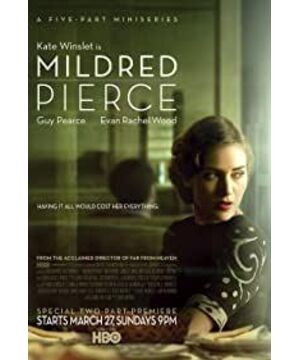The 1945 version of "The Demon of the Sea of Desire" can be regarded as an atypical noir film. There are still crimes, suspense, desires, and the role of a femme fatale like Veda, but the role of Mildred Pearce makes This film has a deep warmth and more emotional entanglements. Joan Crawford’s performance fully expresses a mother’s helplessness and love and hatred for her daughter, and the rhythm of the whole film flashback to reveal the truth is also very cleverly arranged, making the tired Mildred in the police station different. The contrast of the various emotional states of the period made her feel even more difficult, and Joan Crawford also won the Oscar for Best Actress with this film. The 1945 version of Veda is like the classic femme fatale in the film noir, as if she was born venomous. She is selfish, ups and downs, and at the same time willful and fanciful. The entanglement between her and her mother can be described as an unforgettable debt under the affection of her mother. . At that time, the characterization of the characters in Hollywood movies was not as popular as the three-dimensional and enriched ones that are popular today. Therefore, Veda, which is obviously "poisonous", must pay a price.
Compared with the 1945 version, the 2011 version of "The Demon of the Sea of Love" is actually more similar in the character setting. The film starts to the moment when Monty first appeared, and the plot after that has basically nothing to do with the original version. As a 5-episode miniseries, it is a director like Todd Hines who has left out the murder plot, but allows this version to explore the character and emotional evolution of the characters to a greater extent. For example, in the death of Mildred Pierce's young girl, it was different from the original version after a emotional climax. Here, a more detailed performance was made, including changes in the young girl's illness, Mildred's emotional changes, and the atmosphere of the final death to the funeral. They are all more delicate and touching, which is obviously the focus of this edition, no longer entangled in the struggle between good and evil, but to show the ethical tragedy of a family. And Veda's changes have also been more focused in this film. She is no longer a natural villain. Although she showed some stubbornness when she was a girl, her emotional changes can be traced until the celebrity actress becomes an adult. Our common mother-daughter dialogue is that the mother says a lot of things that she hopes to help, and the daughter says no, but thank you. This is the entangled emotions between mother and daughter, one wants to over-care, the other wants independence, wants to escape. After the death of the young girl, Mildred devoted her love to Veda unreservedly. Even if Veda made excessive actions and provocations again and again, she would still give him a deeper doting after being annoyed, which in turn made Veda even more disgusted. , Feels controlled, and at the same time believes that her mother has no bottom line, and she can pursue the lifestyle she thinks is appropriate at will.
Mildred Pierce is a more tragic character in the play than in the movie version. When she was a housewife, she divorced a good old husband. Then she went out and worked hard and became a wealthy businessman in an absolutely inspirational process, but her guilt over the death of her young girl and her doting on Veda have always been a hard injury to her heart. We often say that poor people must have something to hate, but for Mildred, who was almost taken away from him in the end, we really can't bear to say that. We can only say that there must be something sad. In fact, she and her daughter did not have much communication, blindly trying to guide her daughter's life trajectory with her own position and method, and again and again indulged her daughter's deliberate deviation when confronted. And when her daughter tried to be independent, she had a natural maternal instinct and a compensatory psychology for the past, repeating the same mistakes as an adult daughter who could have walked her own way. In the end, she was almost indirectly robbed of everything by her daughter, love, career, family, and life. But on the other hand, it seemed that all of this seemed to be set for herself, and she unintentionally and fatefully walked in.
At the end of the film, although there was no sound of the original gunshots, there was also no warmth of reunion. Only the mother's rants to her daughter and the complete imbalance were left. It was difficult to restore peace. This is the deepest tragedy. The 2011 version of "The Devil of the Sea of Love" has a slower rhythm, especially the first two episodes, even a little hypnotic, but since the death of the young girl, the contradictions have been intensified. Although the rhythm continues to be slow, the tension and conflict points of the plot continue to flash, greatly Strengthen the ornamental. Kate Winslet’s performance is still in place. There are a lot of emotional changes in this character. Winslet is still able to deal with it freely. However, I personally think that it is the mother of Joan Crawford’s version that feels more bitter, and at the same time has more emotional control. Good, but more emotional impact. I feel the same as many of my friends. The cast of Veda Girls’ version is really speechless. When Veda comes out in adulthood, it’s truly amazing that the destructive magical power of the "Female Big Eighteen Transfiguration" has actually come to an end. The effect of content. Of course, what I admire most is the good old man Mr. Pierce, and in the end, he has become Mildred's greatest support in life.
The huge difference in positioning and style between the two versions of "The Demon of Desire for the Sea" is huge, but they also have a similar main context, which makes it a lot of fun to compare and watch the two versions together. Both films are very attractive works, and there is no absolute distinction between good and bad, and the performances of the two Oscar-level actresses are very chewy, from film noir to literary family drama, Mildred Pierce's fate The tragedy of the family is the same when changing and not changing.
http://hi.baidu.com/doglovecat/blog/item/4708fe03c27f17f609fa9387.html
View more about Mildred Pierce reviews











